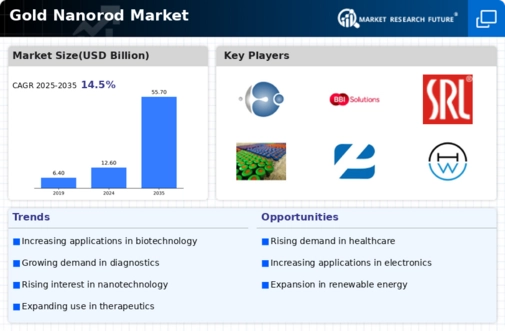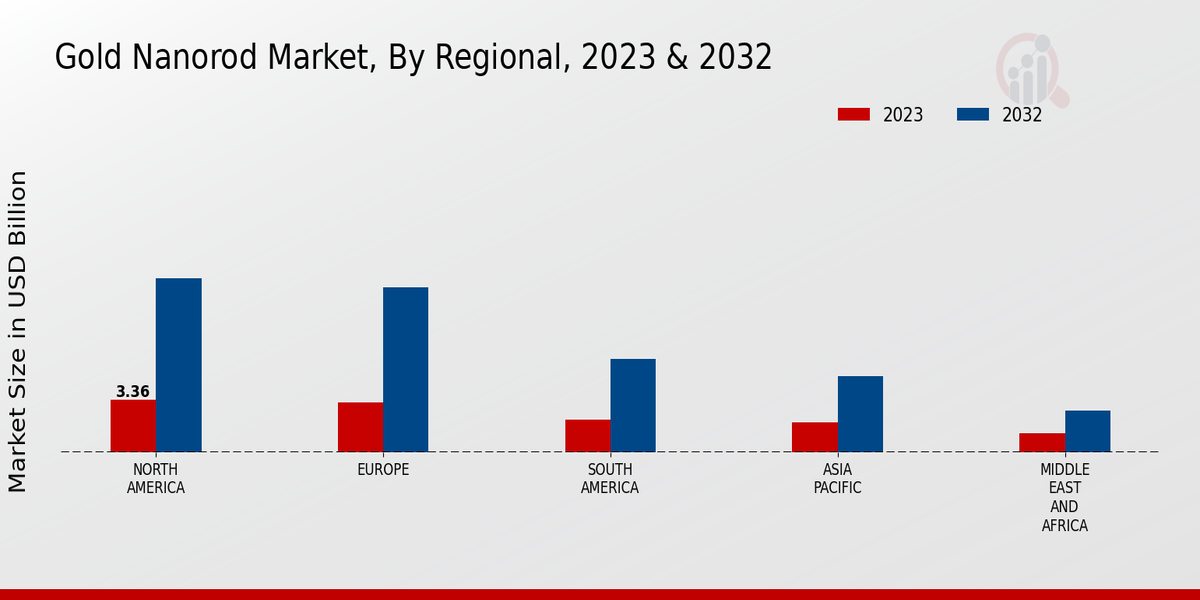Market Growth Projections
The Global Gold Nanorod Market Industry is poised for substantial growth, with projections indicating a market value of 12.6 USD Billion in 2024 and an anticipated increase to 55.7 USD Billion by 2035. This growth trajectory reflects a compound annual growth rate of 14.46% from 2025 to 2035. The expansion is driven by various factors, including advancements in nanotechnology, increasing applications across multiple sectors, and heightened investment in research and development. As industries continue to recognize the potential of gold nanorods, the market is likely to witness significant developments and innovations.
Advancements in Nanotechnology
Technological advancements in nanotechnology play a pivotal role in the Global Gold Nanorod Market Industry. Innovations in synthesis methods and functionalization techniques enhance the properties of gold nanorods, making them more versatile for various applications. For example, the development of new methods for producing uniform and stable gold nanorods has improved their performance in applications ranging from electronics to catalysis. This progress not only boosts the efficiency of existing applications but also opens avenues for new uses, thereby driving market growth. As the industry evolves, the anticipated CAGR of 14.46% from 2025 to 2035 suggests a promising trajectory.
Growing Applications in Electronics
The Global Gold Nanorod Market Industry is witnessing growth due to the expanding applications of gold nanorods in electronics. Their unique electrical and optical properties make them suitable for use in sensors, displays, and other electronic components. For example, gold nanorods are utilized in the development of highly sensitive biosensors that can detect minute quantities of biological substances. As the demand for advanced electronic devices continues to rise, the integration of gold nanorods into these technologies is likely to increase. This trend aligns with the overall growth trajectory of the market, which is projected to reach 12.6 USD Billion in 2024.
Rising Demand in Biomedical Applications
The Global Gold Nanorod Market Industry experiences a surge in demand due to its applications in biomedical fields such as drug delivery and imaging. Gold nanorods exhibit unique optical properties that enhance imaging techniques, making them valuable in diagnostics and therapeutics. For instance, their ability to absorb and scatter light allows for improved contrast in imaging modalities. As healthcare continues to evolve, the integration of gold nanorods into medical devices and treatments is likely to expand, contributing to the market's growth. This trend aligns with the projected market value of 12.6 USD Billion in 2024, indicating a robust future for the industry.
Environmental Applications and Sustainability
The Global Gold Nanorod Market Industry is increasingly influenced by the focus on environmental applications and sustainability. Gold nanorods are being explored for their potential in environmental remediation, such as water purification and pollutant detection. Their high surface area and reactivity make them effective in adsorbing contaminants, contributing to cleaner water sources. As global awareness of environmental issues rises, the demand for sustainable solutions is likely to grow, positioning gold nanorods as a viable option. This shift towards environmentally friendly technologies may further enhance the market's growth, aligning with the projected CAGR of 14.46% for 2025 to 2035.
Increasing Investment in Research and Development
Investment in research and development is a significant driver for the Global Gold Nanorod Market Industry. Governments and private entities are increasingly funding projects aimed at exploring the potential of gold nanorods in various sectors, including energy, electronics, and environmental applications. This influx of capital fosters innovation and accelerates the commercialization of new technologies. For instance, research initiatives focusing on the use of gold nanorods in solar energy conversion are gaining traction, potentially leading to breakthroughs in renewable energy solutions. Such investments are expected to contribute to the market's growth, with projections indicating a market value of 55.7 USD Billion by 2035.











